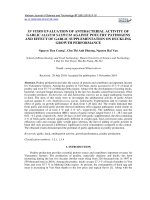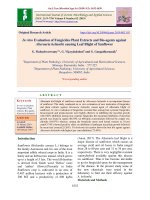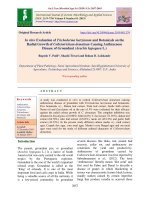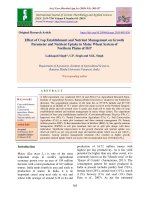In vitro evaluation of bioagents against fusarium wilt of China aster caused by fusarium oxysporum f. sp. callistephi and its effect on growth parameters under pot condition
Bạn đang xem bản rút gọn của tài liệu. Xem và tải ngay bản đầy đủ của tài liệu tại đây (192.62 KB, 9 trang )
Int.J.Curr.Microbiol.App.Sci (2019) 8(10): 1773-1781
International Journal of Current Microbiology and Applied Sciences
ISSN: 2319-7706 Volume 8 Number 10 (2019)
Journal homepage:
Original Research Article
/>
In vitro Evaluation of Bioagents against Fusarium Wilt of China Aster
caused by Fusarium oxysporum f. sp. Callistephi and its effect on Growth
Parameters under Pot Condition
G. Krishna1*, S. K. Nataraj1, R. Rajeshwari2, B. N. Kirtimala3 and H. Nagaraj4
1
Department of Floriculture and Landscape Architecture, 4Department of Plant Pathology,
College of Horticulture, Mudigere, India
2
Department of Plant Pathology, College of Horticulture, Mysuru, India
3
Department of Floriculture and Landscape Architecture, College of Horticulture,
Mysuru, India
*Corresponding author
ABSTRACT
Keywords
China aster,
Bioagents,
Trichoderma
harzianum,
Fusarium
oxysporum f. sp.
Callistephi
Article Info
Accepted:
12 September 2019
Available Online:
10 October 2019
The present study was conducted by using six bioagents against fusarium
wilt of China aster caused by Fusarium oxysporum f. sp. callistephi under
in vitro condition during the year 2018-19. Among the bioagents
Trichoderma harzianum was found significantly superior over other
bioagents in arresting the growth of pathogen and exhibited 90.06 per cent
inhibition with respect to effect of bioagents alone and with fusarium
inoculated treatments on growth parameters under pot culture. It was
revealed that the treatment Trichoderma harzianum alone recorded
significantly higher growth parameters like maximum plant height (57.67
cm), number of branches per plant (3.78), plant spread (463.42 cm2),
maximum days to first flowering (64.33) was taken and maximum number
of flowers per plant (22.50) respectively compare to control.
Introduction
China aster [Callistephus chinensis (L.) Nees.]
is an important winter annual flower and
ornamental plant, belonging to the family
Asteraceae, with the diploid chromosome
number of 2n = 18. The crop is native to
China, spread to Europe and other tropical
countries in 1731 A.D (Desai, 1967). The
genus Callistephus is derived from two Greek
words Kalistos meaning „most beautiful‟ and
Stephos „a crown‟ referring to the flower head.
It was first named by Linnaeus as Aster
chinensis and Nees changed to Callistephus
chinensis (Janakiram, 2006). The crop is
cultivated throughout the world for cut flower,
loose flower, in garden as flower beds and
borders. In India, China aster is commercially
1773
Int.J.Curr.Microbiol.App.Sci (2019) 8(10): 1773-1781
grown in the states of Karnataka, Tamilnadu,
Maharashtra, Telangana, Andhra Pradesh, and
West Bengal (Ramya et al., 2019). In
Karnataka, it is widely cultivated in
Bengaluru, Chitradurga, Tumkur, Belagavi,
Gadag, Bagalkot and Kolar districts in an area
of 2,194 hectares with total production of
20,646 MT and the productivity of 9.41 t/ ha
(Anon, 2015). It is grown successfully in an
open condition during kharif, rabi and
summer seasons for year around supply of
flowers.
The major production constraints of China
aster are the incidence of fungal diseases such
as fusarium wilt and botrytis. Among these
fusarium wilt is the most destructive one and
causes substantial crop yield loss (Horita et
al., 2016). Fusarium oxysporum is a welldescribed soil-borne fungus (Gordon and
Martyn, 1997) includes wide diversity of
strains responsible for wilts or rots on many
plant species (Dean et al., 2012). F.
oxysporum-induced diseases cause serious
damage during production and storage
(Gullino et al., 2015). Though the chemical
control is a regular practice in managing the
disease, continuous use of fungicides leads to
a pollution problems, residual effects, toxicity
resistance in pathogen, and imbalance in soil
microbial association. Therefore, alternative
means of disease control are advisable. The
use of biocontrol agents offers good control of
many soil pathogens like Fusarium sp. (Negi
and Raj, 2016). The present investigation was
undertaken with a view to study the effect of
different bioagents alone under in vitro with
combination of fusarium inoculation in pot
culture for the control of fusarium wilt.
Materials and Methods
The in vitro and pot culture experiment was
carried out in the Department of Floriculture
and landscape architecture, College of
Horticulture, Mudigere, during 2018-19.
Isolation and maintenance of culture
The China aster plants showing typical
symptoms of fusarium wilt were collected
from field and the causal fungus was isolated
by adopting the standard tissue isolation
technique. Later, the bit of fungal growth was
transferred to PDA slants for purification and
maintenance of the culture.
Evaluation of bioagents
Totally six bioagents were used for study viz.,
T1-Trichoderma
asperellum,
T2Pseudomonas fluorescens, T3-Arka Microbial
Consortium (AMC), T4- Azorhizophilus spp.
(K solubilising bacteria), T5-Bacillus subtilis,
T6-Trichoderma harzianum were tested in
vitro against Fusarium oxysporum f. sp.
callistephi by using dual culture technique
(Dennis and Webster, 1971). These bioagents
were obtained from College of Horticulture,
Mysuru.
Dual culture technique
Twenty ml of sterilized and cooled potato
dextrose agar was poured into sterile Petri
plates and allowed to solidify. For evaluation
of fungal biocontrol agents, mycelial discs of
Fusarium oxysporum f.sp. callistephi were
inoculated at one end of the Petri plate and
antagonistic fungus was placed opposite to it
on the other end. In case of evaluation of
bacterial antagonist, the bacterium was
streaked one day earlier at one end of the Petri
plate to the middle of the Petri plate and the
test fungus placed at the other end. The plates
were incubated at 27±1°C and zone of
inhibition was recorded by measuring the clear
distance between the margin of the Fusarium
oxysporum f.sp. callistephi and antagonistic
organism. The colony diameter of pathogen in
control plate was also recorded. The per cent
inhibition of growth of the pathogen was
calculated by using the formula suggested by
1774
Int.J.Curr.Microbiol.App.Sci (2019) 8(10): 1773-1781
Vincent (1947).
oxysporum f. sp. callistephi, T7- Fusarium
oxysporum f. sp. Callistephi, T8- Trichoderma
asperellum, T9- Pseudomonas fluorescens,
T10- Arka Microbial Consortium (AMC), T11Azorhizophilus spp., T12- Bacillus subtilis, T13Trichoderma harzianum, T14- Control
(Untreated).
Where,
PI - Per cent inhibition
T - The growth of test pathogen (mm) in the
presence of the antagonist.
The effect of different bioagents on growth of
China aster was determined by taking
observations of plant height (cm), number of
branches per plant, plant spread (cm2), days to
first flowering and number of flowers per
plant.
Pot experiment
Results and Discussion
The experimental design was Completely
Randomized Design (CRD) with fourteen
treatments and three replications for the
statistical analysis. Eighty four pots were
collected and the sterilized soil mixture (i.e.
soil mixed with FYM was treated with
hydrogen peroxide @ 30 ml per litre of water/
m2 for soil sterilization and left it for sun
drying) was filled in pot and kept in shade
house. Next day, one month old rooted China
aster seedlings (3 seedling/ pot) were planted.
In vitro evaluation of bioagents against
Fusarium oxysporum f. sp. callistephi
C - The growth of test pathogen (mm) in the
absence of the antagonist.
The plants were treated with bioagents alone
and fusarium inoculated culture prepared in
laboratory. The treatments were given by
drenching different bioagents and fusarium
culture of about 50 ml suspended pure culture
around the root zone of plants within 10 days
after transplanting of seedlings. Treatment
details were T1- Trichoderma asperellum +
Fusarium oxysporum f. sp. callistephi, T2Pseudomonas fluorescens + Fusarium
oxysporum f. sp. callistephi, T3- Arka
Microbial Consortium (AMC) + Fusarium
oxysporum
f.
sp.
callistephi,
T4Azorhizophilus spp. + Fusarium oxysporum f.
sp. callistephi, T5- Bacillus subtilis +
Fusarium oxysporum f. sp. callistephi, T6Trichoderma
harzianum
+
Fusarium
The antagonistic effect of six biocontrol
agents were evaluated against Fusarium
oxysporum f. sp. callistephi and the results are
presented in Table 1 and Plate 1. The highest
per cent inhibition was noticed in T6Trichoderma harzianum (90.06 %). The next
best treatment was observed in T. asperellum
(86.28 %), Arka Microbial Consortium (77.78
%), P. fluorescens (67.28 %), B. subtilis
(61.11 %). Whereas, least per cent inhibition
was recorded in the treatment Azorhizophilus
spp. (37.56 %) compare to other treatments.
This inhibition may be due to volatile and
non-volatile metabolites and cell wall
degrading enzymes produced by Trichoderma
sp.
This may be also due to undeniably its mode
of action like competition, antibiosis and
mycoparasitim and it possess some important
secondary metabolites and antibiotics like
viridin, harzianiol and so many. These
findings are also in conformity with Pawan
and Vijay (2011) in chrysanthemum, Kishore
et al., (2007) in gerbera, Rajput et al., (2013)
in marigold, Kavita et al., (2017) in carnation.
1775
Int.J.Curr.Microbiol.App.Sci (2019) 8(10): 1773-1781
Effect of bioagents and Fusarium
oxysporum f. sp. callistephi inoculation on
growth and flowering of China aster under
pot condition
The differences in the plant height as
influenced by different bioagents and fusarium
inoculated treatments were found significant
and it ranged from 30.78 cm to 57.67 cm
(Table 2). Among the bioagents and fusarium
inoculated treatments, the higher plant height
(57.67 cm) was observed in the bioagent
Trichoderma harzianum (T13) alone, it is on
par with T. asperellum (56.46 cm) and Arka
Microbial Consortium (55.67 cm). The next
best combined treatment were T. harzianum +
F. oxysporum f. sp. callistephi (54.33 cm), T.
asperellum + F. oxysporum f. sp. callistephi
(54.00 cm) were recorded higher plant height.
Significantly, minimum plant height was
recorded in F. oxysporum f. sp. callistephi
(30.78 cm) compare to other treatments.
Bioagents produce several growth promoting
hormones (auxins, cytokinins and gibberellins
etc.) in addition to increasing the availability
of nitrogen and phosphorus to the plants
resulting in better plant growth. These results
are in conformity with the findings of
Brandler et al., (2017) in gerbera,
Ramakrishna et al., (2013) in gladiolus, Nosir
(2016) in tuberose, Manooanjitham et al.,
(2000) in chilli.
The differences in the number of branches per
plant as influenced by different bioagents and
fusarium inoculated treatments were found
significant and it ranged from 2.78 to 3.78
(Table 2). Among the bioagents and fusarium
inoculated treatments, the maximum number
of branches per plant (3.78) was observed in
the bioagent Trichoderma harzianum (T13)
alone, it is on par with T. asperellum (3.67),
Arka Microbial Consortium (3.67) and
Azorhizophilus spp. (3.58). The combined
treatment T. harzianum + Fusarium
oxysporum f. sp. callistephi (3.42), T.
asperellum + F. oxysporum f. sp. callistephi
(3.42) were next best treatments recorded
maximum number of branches per plant.
Significantly, minimum numbers of branches
per plant were recorded in the F. oxysporum f.
sp. callistephi (2.78) compare to other
treatments. These results may be due to the
role of bioagents in nutrient uptake and
production of growth promoting substances
such as indole acetic acid and gibberellins
which led to more number of flowering
branches per plant. These results are in
agreement with the reports of Brandler et al.,
(2017) in gerbera.
Table.1 In vitro evaluation of bioagents against Fusarium oxysporum f. sp. callistephi
Treatments
Per cent inhibition (%)
T1- Trichoderma asperellum
T2- Pseudomonas fluorescens
T3- Arka Microbial Consortium
T4- Azorhizophilus spp.
T5- Bacillus subtilis
T6- Trichoderma harzianum
S. Em. ±
CD @ 1%
86.28
67.28
77.78
37.56
61.11
90.06
0.72
2.82
1776
Int.J.Curr.Microbiol.App.Sci (2019) 8(10): 1773-1781
Table.2 Effect of bioagents and Fusarium oxysporum f. sp. callistephi inoculation on growth
parameters of China aster under pot condition
Treatments
Plant
height
(cm)
Plant
spread
(cm2)
Days to
first
flowering
Number
of flowers
per plant
54.00
Number
of
branches
per plant
3.42
T1- Trichoderma asperellum
+ Fusarium oxysporum f. sp.
callistephi
T2- Pseudomonas
fluorescens + Fusarium
oxysporum f. sp. callistephi
T3- Arka Microbial
Consortium + Fusarium
oxysporum f. sp. callistephi
T4- Azorhizophilus spp. +
Fusarium oxysporum f. sp.
callistephi
T5- Bacillus subtilis +
Fusarium oxysporum f. sp.
callistephi
T6- Trichoderma harzianum
+ Fusarium oxysporum f. sp.
callistephi
T7- Fusarium oxysporum f.
sp. callistephi
T8- Trichoderma asperellum
T9- Pseudomonas
fluorescens
T10- Arka Microbial
Consortium
T11- Azorhizophilus spp.
T12- Bacillus subtilis
T13- Trichoderma harzianum
T14- Control (Untreated)
S. Em. ±
CD @ 1%
394.21
68.25
14.10
49.40
3.22
364.73
68.33
12.00
53.89
3.35
381.36
68.40
14.00
53.67
3.33
356.76
68.50
10.33
45.42
3.22
338.80
68.78
8.67
54.33
3.42
406.89
68.18
16.00
30.78
2.78
323.16
70.33
6.12
56.46
54.89
3.67
3.50
450.40
425.21
64.78
65.78
22.22
20.89
55.67
3.67
438.81
66.33
21.34
55.27
54.78
57.67
54.50
0.50
2.14
3.58
3.44
3.78
3.42
0.05
0.20
434.81
416.09
463.42
412.89
6.15
24.03
67.22
67.44
64.33
68.11
0.60
2.44
21.22
20.67
22.50
19.00
0.26
1.03
1777
Int.J.Curr.Microbiol.App.Sci (2019) 8(10): 1773-1781
Plate.1 In vitro dual culture technique
Plate.2 Comparison of Trichoderma harzianum and Fusarium inoculated treatment
condition
Trichoderma harzianum
Fusarium inoculated
1778
under pot
Int.J.Curr.Microbiol.App.Sci (2019) 8(10): 1773-1781
The differences in the plant spread as
influenced by different bioagents and
Fusarium inoculated treatments were found
significant and it ranged from 323.16 cm2 to
463.42 cm2 (Table 2). Among the bioagents
and fusarium inoculated treatments, the
maximum plant spread (463.42 cm2) was
observed in the bioagent Trichoderma
harzianum (T13) alone, it is on par with T.
asperellum (450.40 cm2). The combined
treatments T. harzianum + Fusarium
oxysporum f. sp. callistephi (406.89 cm2), T.
asperellum + F. oxysporum f. sp. callistephi
(394.21 cm2) were recorded maximum plant
spread. Significantly, minimum plant spread
was recorded in the F. oxysporum f. sp.
callistephi (323.16 cm2) compare to other
treatments. Maximum plant spread could be
due to the increase in stem girth and number
of branches per plant. These results are similar
to Brandler et al., (2017) in gerbera,
Ramakrishna et al., (2013) in gladiolus,
Manooanjitham et al., (2000) in chilli.
The differences in the days for first flowering
as influenced by different bioagents and
fusarium inoculated treatments were found
significant and it ranged from 64.33 days to
70.33 days (Table 2). Among the bioagents
and fusarium inoculated treatments, the
minimum days for first flowering 64.33 days
was observed in the bioagent Trichoderma
harzianum (T13) alone, it is on par with T.
asperellum (64.78 days), Pseudomonas
fluorescens (65.78 days) and Arka Microbial
Consortium (66.33 days). The combined
treatments T. harzianum + Fusarium
oxysporum f. sp. callistephi (68.18 days), T.
asperellum + F. oxysporum f. sp. callistephi
(68.25 days) were recorded minimum days for
first flowering. Significantly, maximum days
for first flowering was observed in the F.
oxysporum f. sp. callistephi (70.33 days)
compare to other treatments. The reason for
earliness in flowering can be proper uptake of
nutrients and production of growth promoting
substances like auxins, gibberellins, vitamins
and organic acids by the T. harzianum.
Thereby, plant completed its vegetative
growth soon, resulting in early flowering.
These finding are in conformity with the
findings of Brandler et al., (2017) in gerbera,
Ramakrishna et al., (2013) in gladiolus, Nosir
(2016) in tuberose.
The differences in the number of flowers per
plant as influenced by different bioagents and
fusarium inoculated treatments were found
significant and it ranged from 6.12 to 22.50
across different treatment (Table 2). Among
the bioagents and fusarium inoculated
treatments, the maximum number of flowers
per plant 22.50 were observed in the bioagent
Trichoderma harzianum (T13) and it is on par
with T. asperellum (22.22) and Arka
Microbial Consortium (21.34). The combined
treatments T. harzianum + F. oxysporum f. sp.
callistephi (16.00), T. asperellum + F.
oxysporum f. sp. callistephi (14.10) were
recorded maximum number of flowers per
plant. Significantly, minimum number of
flowers per plant were recorded in the F.
oxysporum f. sp. callistephi (6.12) compared
to other treatments. The T. harzianum had
recorded maximum plant height, more number
of branches, plant spread and it was early
flowering and resulted in more number of
flowers per plant. The increase in number of
flowers may be due to possible role of
bioagents through better root proliferation,
uptake of nutrients and water. Besides this,
increase in flower yield may be attributed to
increased availability of phosphorous and its
greater uptake due to application of
Trichoderma. Similar results were obtained by
Brandler et al., (2017) in gerbera,
Ramakrishna et al., (2013) in gladiolus, Nosir
(2016) in tuberose.
The present study conclude that Trichoderma
harzianum inhibited the mycelial growth of
Fusarium oxysporum f. sp. callistephi
1779
Int.J.Curr.Microbiol.App.Sci (2019) 8(10): 1773-1781
effectively under in vitro and among different
bioagents and fusarium inoculated treatments
maximum vegetative growth and flowering
was reported with Trichoderma harzianum
under pot condition.
References
Anonymous. 2015. Horticultural Crops
Statistics of Karnataka State at a
Glance, Government of Karnataka,
Department of Horticulture, Lalbagh,
Bangalore.
Brandler, D., Divensi, L.J., Tonin, R.J., Pilla,
T.P., Rezendes, I. and Milanesi, P.M.
2017. Evaluation of biological control
of fusarium wilt in gerbera with
Trichoderma asperellum. Ornamental
Horticulture. 23(3): 234-239.
Dean, R., Van kan, J.A.L., Pretorius, Z.A.,
Hammond-kosack, K.E., Di pietro, A.,
Spanu, P.D., Rudd, J.J., Dickman, M.,
Kahmann, R., Ellis, J. and Foster, G.D.
2012. The Top 10 fungal pathogens in
molecular plant pathology. Molecular
Plant Pathology. 13: 414-430.
Dennis, C. and Webster, J. 1971. Antagonistic
properties of species groups of
Trichoderma II. Production of volatile
antibiotics. Trans. British Mycological
Society. 57: 41-48.
Desai, B.L. 1967. Flower description in China
aster (Callistephus chinensis) in
seasonal flowers. ICAR Publication,
New Delhi. Pp. 53-56.
Gordon, T.R. and Martyn, R.D. 1997. The
evolutionary biology of Fusarium
oxysporum. Annual Revision of
Phytopathology. 35: 111-128.
Gullino, M.L., Daughtrey, M.L., Garibaldi, A.
and Elmer, W.H. 2015. Fusarium wilts
of ornamental crops and their
management. Crop Protection. 73: 5059.
Horita, H. and Mcgover, R.J. 2016. Diseases
of China aster. Handbook of florists
crops diseases. Pp. 1-20.
Kavita, T.H., Narayanaswamy, H., Kavitha,
S.V. and Manu, T.G. 2017. Efficacy of
bio-agents, botanicals and fungicides
against Fusarium oxysporum f. sp.
dianthi causing wilt of carnation.
International Journal of Chemical
Studies. 5(6): 139-142.
Kishore, C., Kulkarni, S., Hegde, Y.R.,
Jahagirdar, S. and Patil, A.A. 2007.
Studies on diagnosis and management
of fungal wilt diseases of carnation and
gerbera under protected cultivation.
M.Sc. (Agri.) Thesis, University of
Agricultural
Sciences
Dharwad,
Karnataka, India.
Manooanjitham,
S.K.,
Prakasam,
V.,
Rajappan, K. and Amutha, G. 2000.
Control of chilli damping off using
bioagents. Journal of Mycology and
Plant Pathology. 30(2): 225-228.
Negi, H.S. and Raj, H. 2016. Integration of
biocontrol agents and soil amendments
for the management of fusarium wilt in
carnation. Journal of Mycology and
Plant Pathology. 43(3): 367-387.
Nosir, W.S. 2016. Trichoderma harzianum as
a growth promoter and bio-control
agent against Fusarium oxysporum f.
sp. tuberosi. Advances in Crop Science
Technology. 4: 217.
Pawan, K.S. and Vijay, K. 2011. Biological
control
of
fusarium
wilt
of
chrysanthemum with Trichoderma and
botanicals. Journal of Agricultural
Technology. 7(6): 1603-1613.
Rajput, R.B., Solanky, K.U., Prajapati, V.P.,
Pawar, D.M. and Suradkar, S.R. 2013.
Effect of fungal and bacterial
bioagents against Alternaria alternata
in marigold under in vitro condition.
The Bioscan. 8(2): 627-629.
Ramakrishna, K.R., Potdukhe, S.R., Guldekar,
D.D., Chopde, N.K. and Dangore, U.T.
2013. Integrated disease management
of (Fusarium oxysporum f. sp.
1780
Int.J.Curr.Microbiol.App.Sci (2019) 8(10): 1773-1781
gladioli) wilt of gladiolus. M.Sc.
(Agri.)
Thesis,
University
of
Agricultural Science, PDKV, Akola.
Ramya, H.M., Nataraj, S.K. and Rajiv, K.
2019. Character Association and Path
Coefficient Analysis in F2 Segregating
Population of Cross “Arka Kamini x
PG
Violet”
in
China
aster
(Callistephus chinensis [L.] Nees).
International Journal of Currurent
Microbiology and Applied Sciences.
8(4): 1314-1318.
Vincent, J.M. 1947. Distortion of fungal
hyphae in the presence of certain
inhibitors. Nature. 150: 850.
How to cite this article:
Krishna, G., S. K. Nataraj, R. Rajeshwari, B. N. Kirtimala and Nagaraj, H. 2019. In vitro
Evaluation of Bioagents against Fusarium Wilt of China Aster caused by Fusarium oxysporum
f. sp. Callistephi and its effect on Growth Parameters under Pot Condition.
Int.J.Curr.Microbiol.App.Sci. 8(10): 1773-1781. doi: />
1781









![Studies on genetic variability, heritability and genetic advance in F4 population of china aster [Callistephus chinensis L. (Nees.)]](https://media.store123doc.com/images/document/2020_03/02/medium_mqh1583125904.jpg)